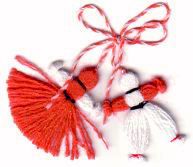| Baba Marta Day | |
|---|---|
 Typical martenitsa | |
| Observed by | Bulgaria |
| Date | 1 March |
| Frequency | annual |
Grandma Marta Day (or simply Baba Marta, Bulgarian: Баба Марта, "Grandma Marta") is a holiday celebrated in Bulgaria, on March 1. Martenitsas, usually in the form of a wrist band, small yarn dolls, or tassels, are created by combining red and white colored threads and are worn on that day and throughout March. They are worn until a stork or a swallow is seen, symbolizing the coming of spring, warmer weather, and well-being. Once the stork or a swallow appears the Martenitsa is taken off and hung on a blooming tree. It is common in the spring to see trees festooned in Martenitsas.
Older Bulgarians call it Birch Month as it is around the time that birch trees start growing leaves and giving sap. There is a great amount of folklore about Grandma Marta Day and the character of Baba Marta herself.[1] The greeting exchanged on this day is Chestita Baba Marta (Bulgarian: Честита Баба Марта, "Happy Baba Marta"), often shortened to ЧБМ on greeting cards.
There are various theories, suggestions, and even several legends involving real historical figures about the symbolism of the red and white colors from which Martenitsa are made. An obvious explanation, and perhaps a common belief people share, is that "red" stands for "life/birth" and "white" denotes "anew/on clear grounds". Combined they mean "newborn", "rebirth", and "a new beginning"; a celebration of life and survival. Another popular explanation is that white stands for wisdom and red for good health, which means that anyone giving you a Martenitsa is wishing you both throughout the new year.
In March these amulets, worn around one's wrists and on their attire, can be seen almost everywhere in Bulgaria and in the neighboring regions. Being a purely pagan ritual by origin, Baba Marta Day is one of the oldest continuing traditions in Christian Europe.
- ^ "Grandmother March Folklore". Archived from the original on 2010-03-04. Retrieved 2008-09-17.